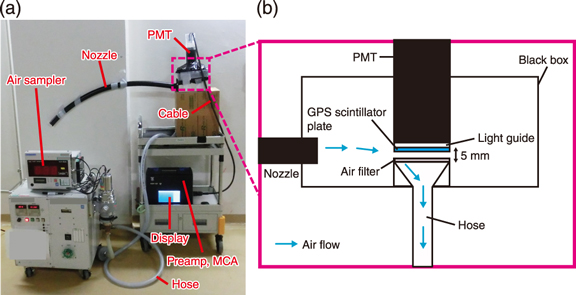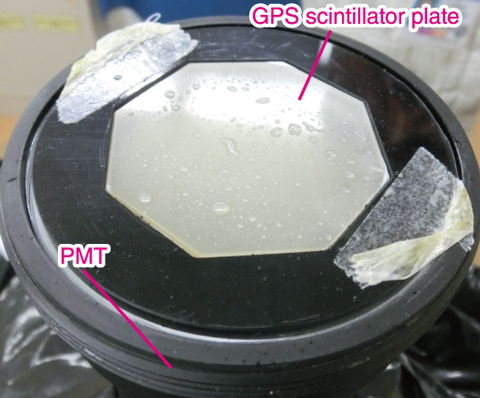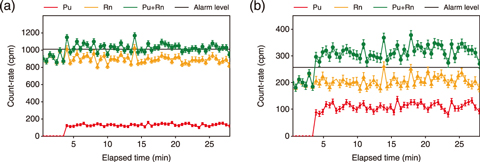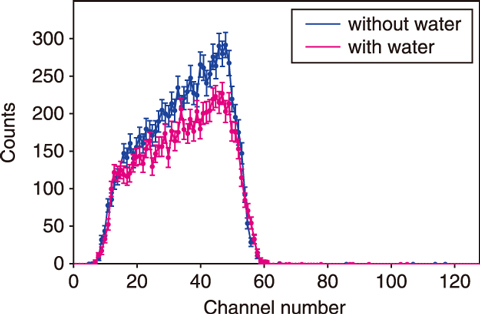
Fig.1-10 Developed (a) alpha dust monitor (b) and sample holder

Fig.1-11 Simulation of the humidity condition

Fig.1-12 Time variation of counts with 30 s intervals

Fig.1-13 Alpha energy spectra with and without dropping water
A dust monitor with a silicon surface barrier detector (SSBD) was introduced at a nuclear fuel facility to detect the airborne concentration of 238Pu and 239Pu released by past accidents. The SSBD energy resolution can distinguish 238Pu and 239Pu from naturally occurring radionuclides, such as radon (Rn) progenies (e.g., 218Po with a 6.0 MeV alpha particle and 214Po with a 7.7 MeV alpha particle). However, the SSBD frequently produces false alarms, especially in rooms with high humidity. Under false alarms, workers must evacuate, thus interrupting operations in the room. Thus, a more reliable dust monitor that has a high energy resolution but is more resilient against external noise is required.
Therefore, an alpha-particle spectrometer based on a cerium-doped Gd2Si2O7 (GPS) scintillator plate and a photomultiplier tube (PMT) was developed, as shown in Fig.1-10. The GPS scintillator plate is hexagonal and 50 mm in diameter with a scintillator layer of approximately 40 μm. The bottom face of the GPS scintillator plate was optically coupled to a PMT (R6233, Hamamatsu Photonics K.K., Hamamatsu, Japan) with a diameter of 3 mm in using an optical grease. The output signal from the PMT is amplified by a preamplifier (5625, Clear pulse CO., LTD., Tokyo, Japan) and transferred to a multi-channel analyzer (MCA; A2731, Clear pulse CO., LTD., Tokyo, Japan). The energy spectrum is then displayed in real-time. The alpha-particle detector was positioned facing downward and the detection end was placed in a black box, which was connected to a nozzle and an air sampler. When the air sampler operates, the nozzle sucks up the air around the monitor, and any radioactive dust in the air is captured by the filter. The distance between the GPS scintillator plate and the filter was approximately 5 mm to allow for air passage. The 241Am alpha source, Rn progeny collected on the air filter, and a PuO2 particle were measured by our developed dust monitor. Water was dropped directly onto the surface of the GPS plate using a dropper to simulate high-humidity conditions (Fig.1-11).
The resulting energy resolution for 5.5-MeV alpha particles was 11.9% ± 0.2% of the FWHM. A 92% efficiency was achieved, as was a uniform sensitivity. To eliminate Rn progeny counts, an energy window was set with the upper (ULD) and lower (LLD) channels of the Pu sample spectrum. By applying the energy window, the count-rate of the Rn progeny decreased by 77% (Fig.1-12). The resulting alpha spectra with and without dropping water are shown in Fig.1-13 for a measurement time of 5 min. The GPS scintillator plate could be used to measure the alpha spectrum even though the GPS scintillator got wet. The ratio of the total counts with/without water was 0.84. The peak number of channels without and with water were similar: 47.1 and 47.3 channels, respectively.
Overall, the developed dust monitor can be used to conduct alpha-particle spectroscopy despite the presence of water on the surface of the GPS scintillator plate. An alpha dust monitor using a GPS scintillator plate is therefore ideal for detecting alpha-particle emitters in places lacking temperature and humidity controls.